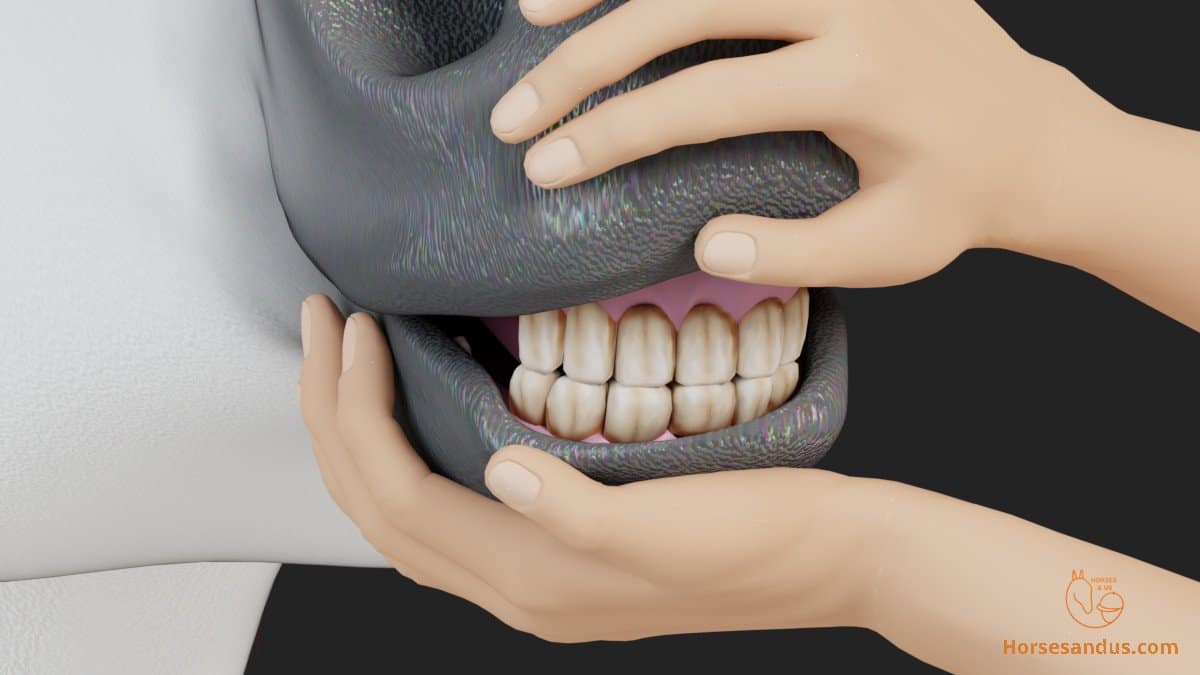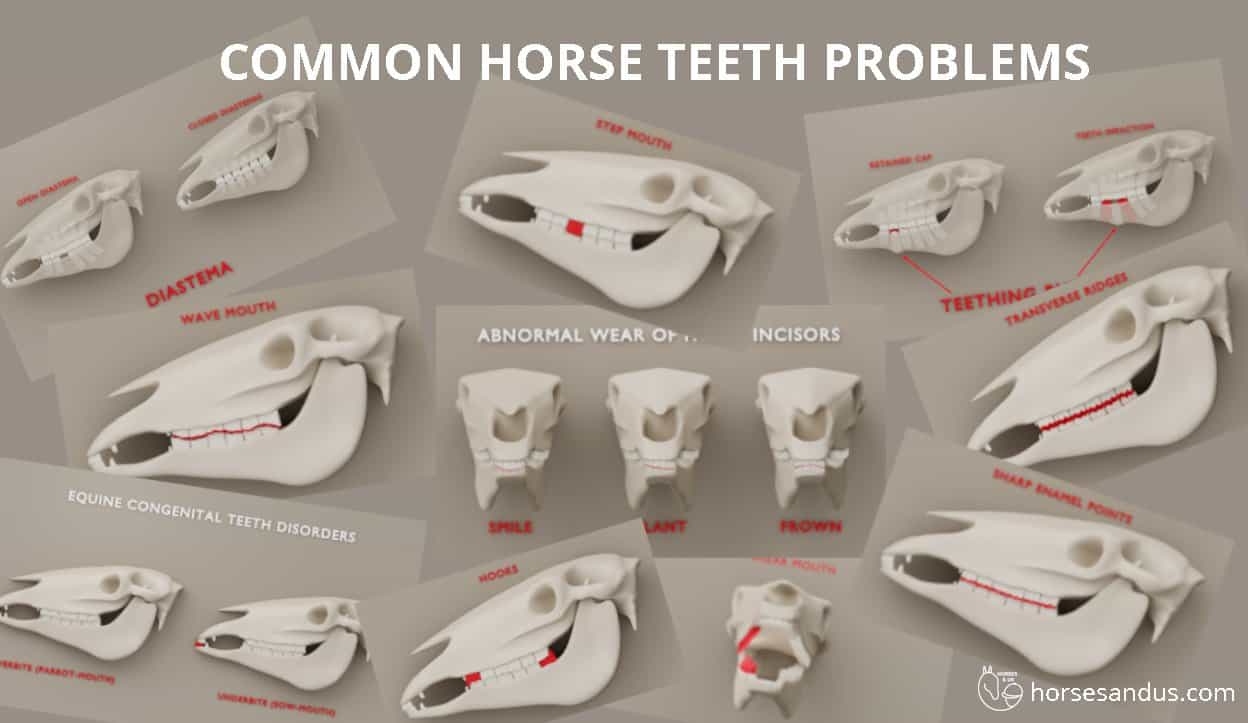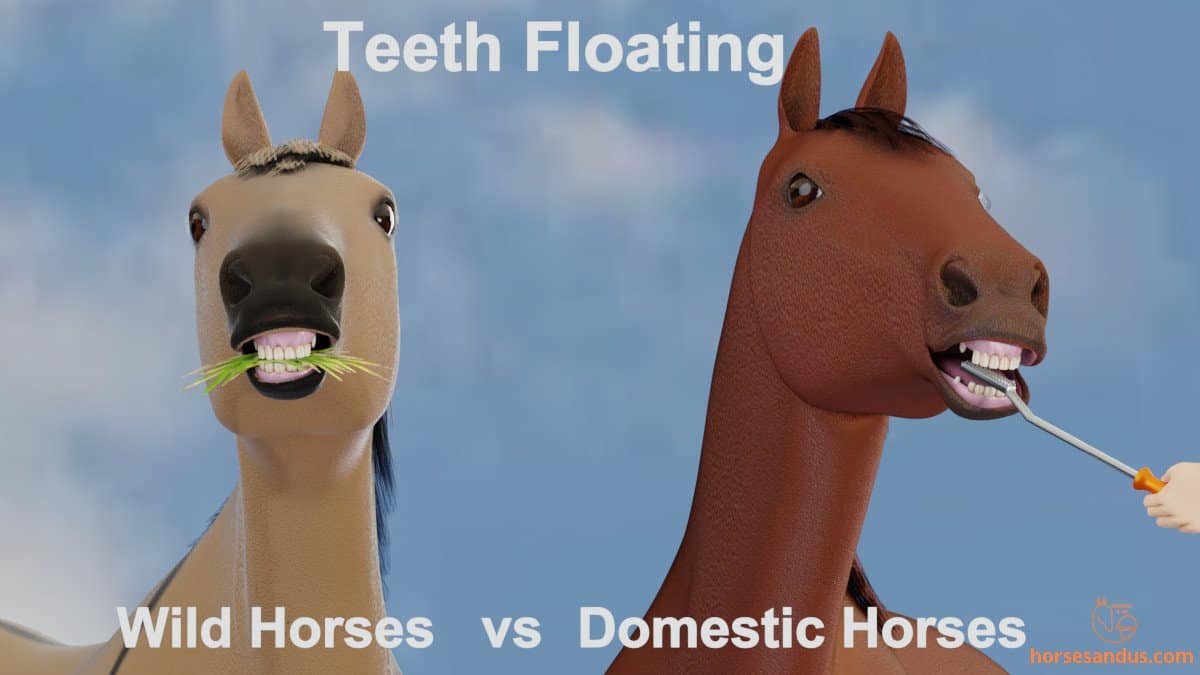Having a basic understanding of horses’ dental terminology is the starting point of your journey to understand horse teeth anatomy and function.
Horses have four types of teeth: incisors, canines, premolars, and molars.
Each type of tooth has certain physical characteristics and specific functions.
- Incisors grasp and cut food
- Canines are for fighting
- Premolars and molars are grinders
- Wolf teeth are classified as premolar but are vestigial and have no function.
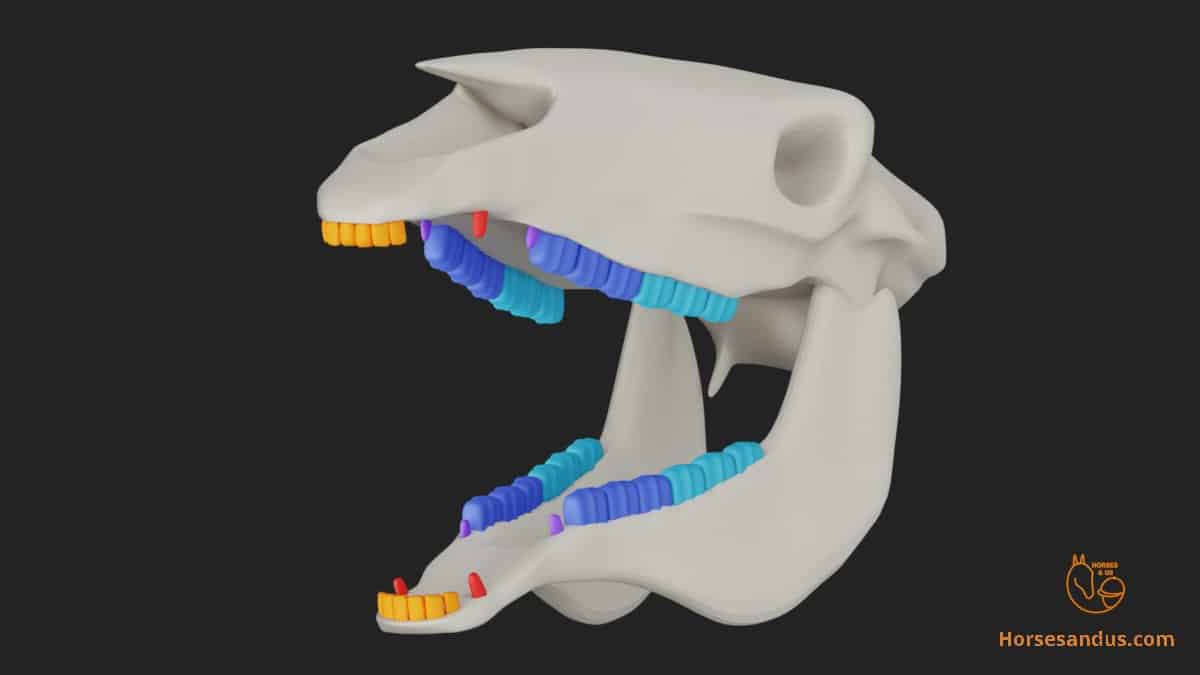
Horse Mouth Anatomy
The horse’s mouth anatomy is quite different from ours because they evolved to eat tough fibrous plants such as grass, and their mouth adapted to this diet.
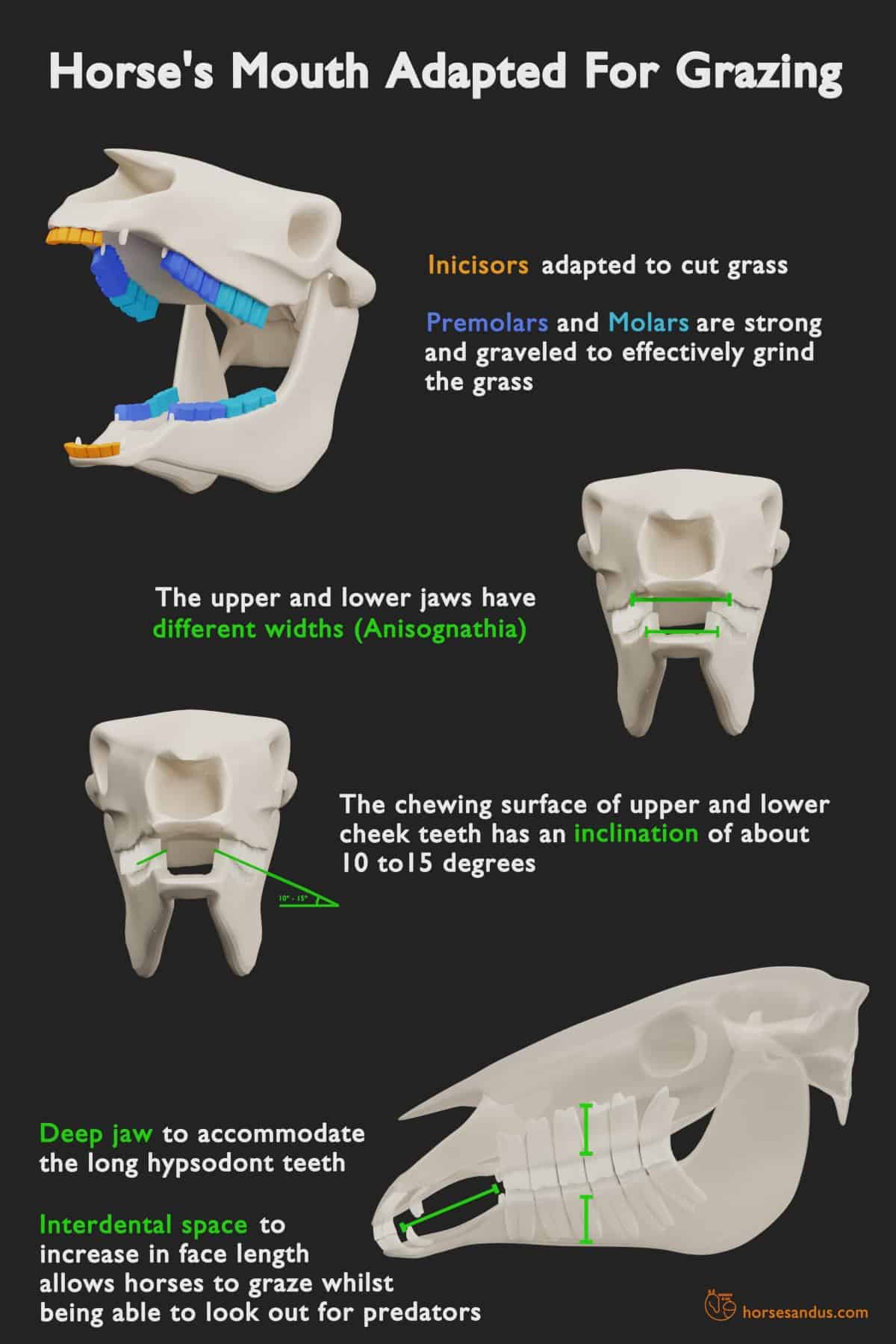
The main adaptations are:
1- Incisors
2- Cheek teeth (molars and premolars)
3- Jaws
4- Hypsodont
Horse Teeth Structure
The horse’s tooth is made up of four layers with different characteristics: pulp, dentin, enamel, and cementum

These three protective layers have different hardness; enamel is the hardest (96-98% mineralized), then comes dentin (70%), and finally cementum (65%)
These materials’ different hardness causes them to wear away at different rates (enamel slowest, dentin, and cementum fastest).
This explains why the teeth’ chewing surface has indentations, with the softer materials lying deeper in the surface than the harder ones. The result is a very irregular graveled surface, with relatively sharp edges perfect for crushing coarse fibrous feed.
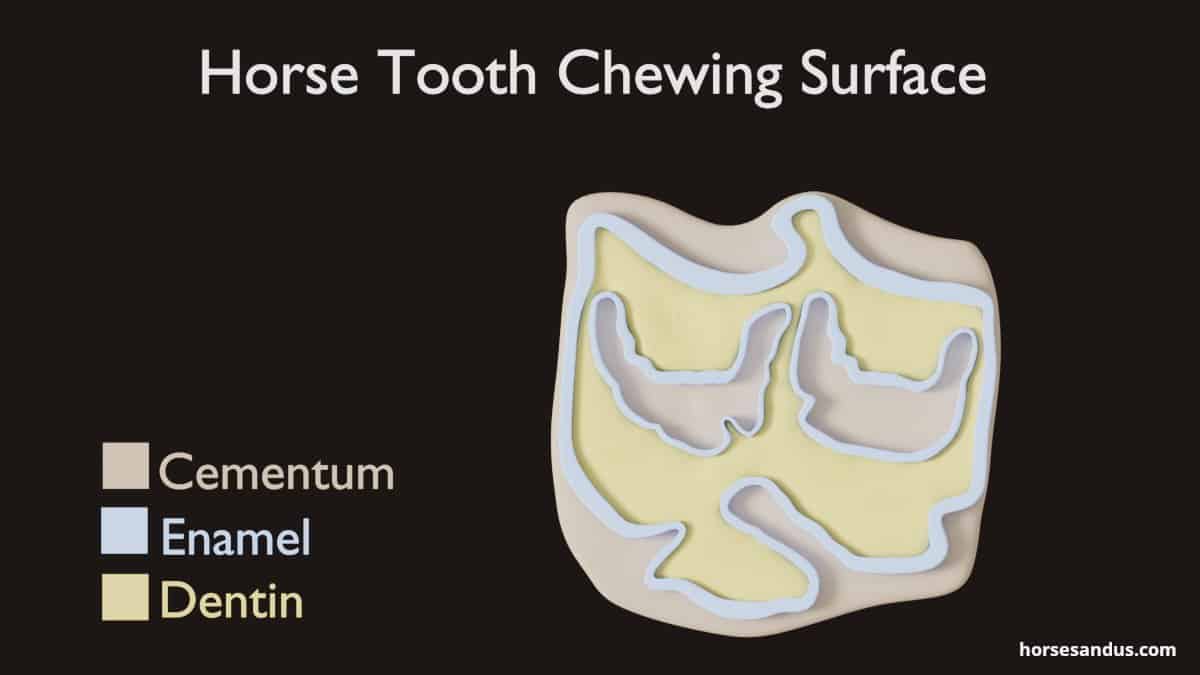
This rough chewing surface should not be smoothed out when floating a horse’s teeth (unless the tooth is abnormally long or the angle is wrong). The horse will feel pain and be unable to chew his food properly for some time.
Horse Hypsodont Teeth
Horses have very long hypsodont teeth (4 – 5 inches/ 10-12cm). Most of the tooth is a reserve hidden below the gum line. This reserve continually erupts during the horse’s lifetime as the teeth wear away due to the grinding of fibrous feed.
Many people are not aware of how much tooth is hidden below the gum line.
Horse teeth are very different from human teeth.

| Horse Teeth | Human Teeth |
|---|---|
| Hypsodont type | Brachydont type |
| Crown is long and divided into a visible crown above the gumline and a reserve crown that is hidden below the gumline | Crown is short and ends at the gum |
| The root is short, so the reserve crown acts as a root to help stabilize the tooth inside the socket. | The root is long |
| Continuous growth during the horse’s lifetime | Stop growing after the crown has completely emerged |
During the horse’s lifetime, their teeth slowly push (erupt) through the gum line at a rate of ⅛ inch / 2-3mm a year, which is similar to the rate of wear on the surface of the tooth.
The size of the tooth above the gumline (the visible crown) always remains the same. However, below the gum line, the tooth becomes shorter and shorter as the horse grows older.
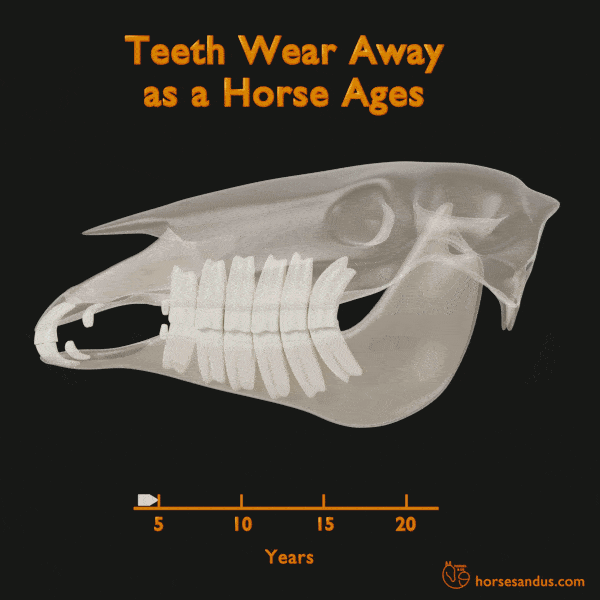
The rate of eruption compensates for the rate of wear, as long as the horse is eating grass (or some alternative fibrous feed such as hay or silage).
If instead, he is being fed high quantities of concentrate food, then the rate of surface wear will be reduced. Also, the range of lateral chewing action will be more limited. This results in dental overgrowths such as sharp points and shear mouth.
Considering that horse’s teeth:
- Have an initial length of approximately 4 inches (10-12cm)
- Push through and wear away at a rate of 2 to 3mm per year
We can estimate that a healthy horse eating an ideal diet will have teeth that do not wear out completely for 25 to 30 years. After this age, the teeth will eventually “disappear.”
Triadan Tooth Numbering System – Horse Teeth
To avoid confusion when referring to specific teeth, a numbering system, called the Triadan system, was developed and is used worldwide.
The Triadan System is used for numbering teeth in different animal species, including equines.
It uses 3 digits to identify each tooth. The first digit refers to the quadrant: left and right maxilla, and left and right mandible.
The quadrants are numbered 1 to 4, starting at the right maxilla and ending at the right mandible in a clockwise direction, as seen in the image below. The deciduous teeth are identified similarly, but the quadrants are numbered 5 to 8.
The second and third digits identify the tooth position within the quadrant.
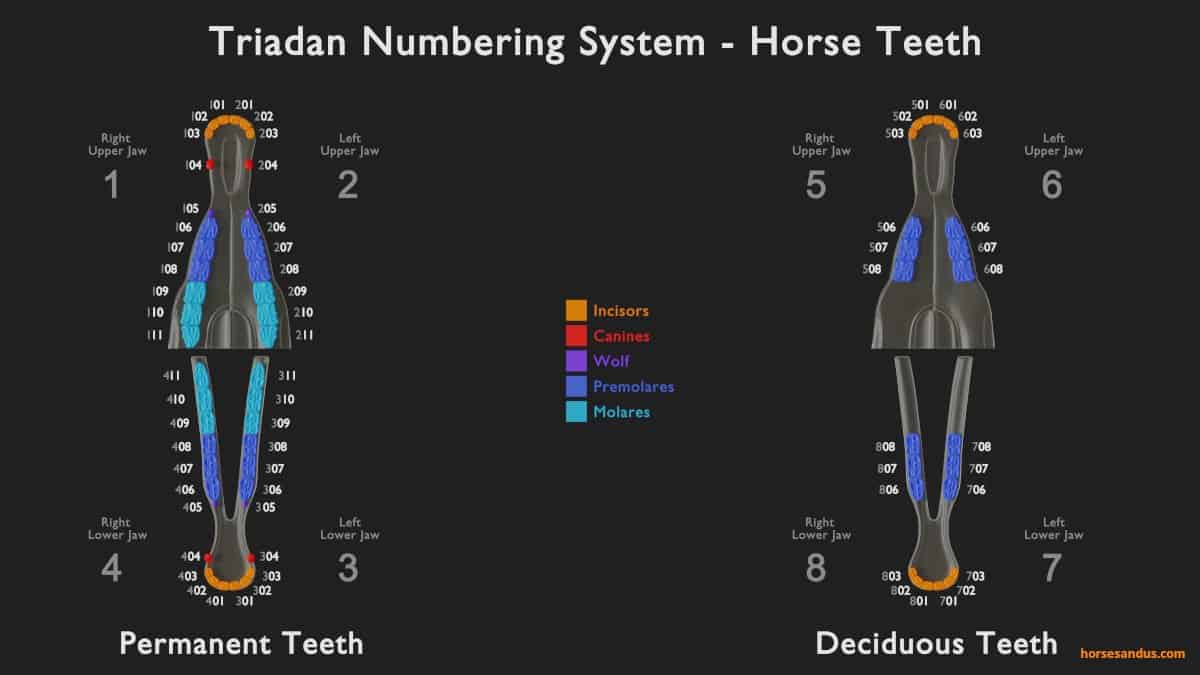
The image shows the Triadan system for horses’ permanent teeth and horses’ deciduous teeth.
Horse Incisors
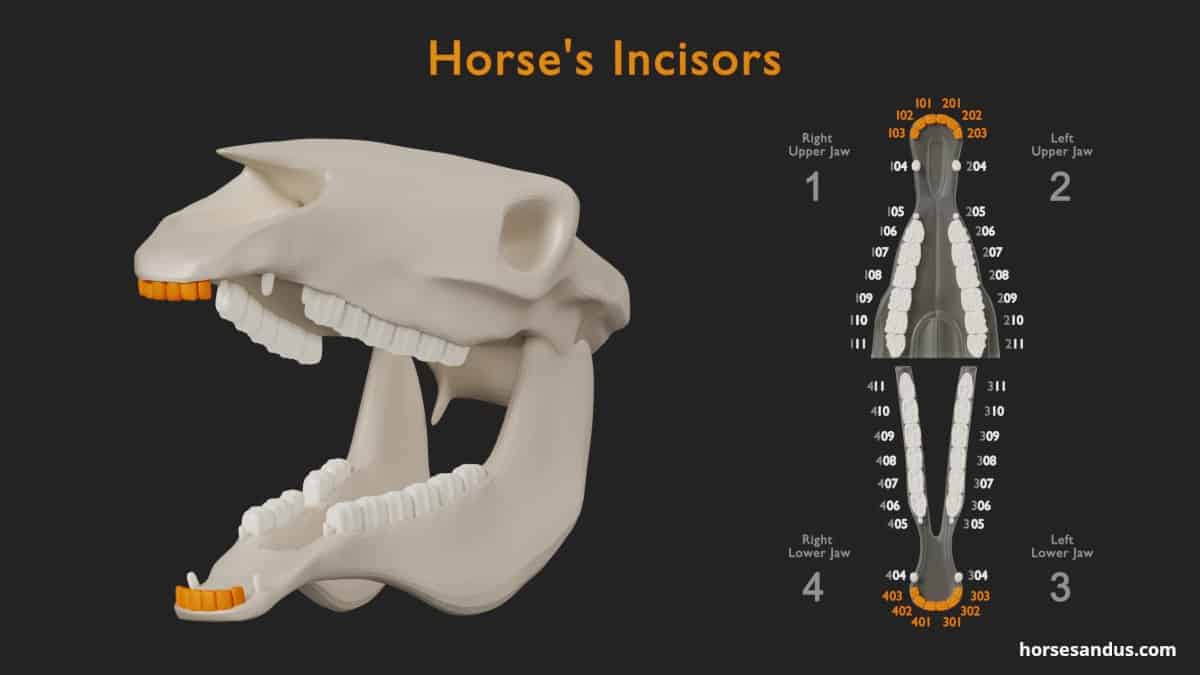
The horse´s incisors are the teeth at the front of the mouth. (Triadan 01’s to 03’s)
Deciduous (baby) Incisors
The deciduous incisors erupt around the following ages:
- Central (01’s) during the first week of age
- Intermediate (02’s) between 4 and 6 weeks of age
- Corner (03’s) erupt much later at 6 to 9 months of age.
Deciduous Teeth eruption charts can be seen in our article about how to tell a horse´s age by its teeth (before 5 years).
These baby incisors have a short crown and are wider and whiter than the permanent teeth that will later replace them. The deciduous incisors (caps) shed as the corresponding permanent incisors emerge.
Permanent (adult) Incisors
The permanent incisors erupt around the following ages
- Central (01’s) at 2.5 years of age
- Intermediate (02’s) at 3.5 years of age
- Corner (03’s) at 4.5 years of age.
Permanent Teeth eruption charts can be seen in our article how to tell a horse´s age by its teeth (after 5 years).
Facts About Incisors
Horse Canine Teeth

The horse’s canine teeth (Triadan 04’s) are located between the incisors and premolars.
They were originally “fighting teeth”, and have no use in the eating process.
Deciduous (baby) Canines
In both male and female horses, the deciduous canines do not erupt above the gumline.
Permanent (Adult) Canines
Permanent canine teeth erupt between 4 and 6 years of age.
Facts About Canines
Horse Wolf Teeth

The horse´s wolf teeth (Triadan 05’s) are very small vestigial premolars located in front of the first cheek teeth.
Facts About Wolf Teeth
Horse Cheek Teeth

The horse´s cheek teeth are the teeth at the back of the mouth. (Triadan 06’s to 11’s)
There are 24 cheek teeth (molars and premolars) in an adult horse. Each row has 6 teeth. The first 3 in each row are the premolars, and the last 3 are molars.
The cheek teeth, with strong graveled surfaces, are used for crushing and grinding the food.
Only the premolars have deciduous teeth.
Deciduous (Baby) Premolars
The deciduous premolars (06´s, 07’s, 08’s) have erupted at birth or erupt a few days later until 2 weeks of age.
The crowns of the deciduous premolars are very similar to the permanent premolars.
As the foal grows older, the crowns become thinner by wear (caps). Over time the caps loosen and fall off as the underlying permanent teeth erupt.
Permanent (Adult) Premolars
The permanent premolars erupt around the following ages:
- (06’s) at 2.5 years of age
- (07’s) at 3 years of age
- (08’s) at 4 years of age.
The molars do not have deciduous precursors.
Permanent (Adult) Molars
The permanent molars erupt around the following ages:
- (09’s) at 1 year of age
- (10’s) at 2 years of age
- (11’s) at 3.5 years of age.
Facts About Molars
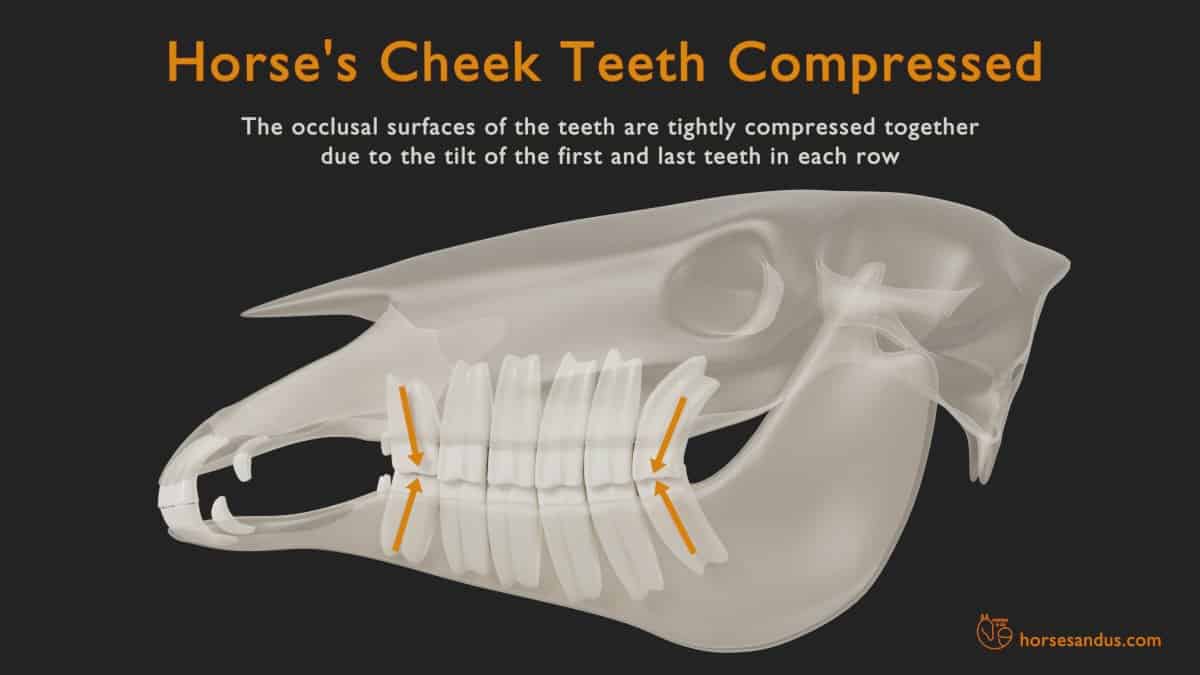
- The maxillary (upper jaw) cheek teeth are square-shaped (except for the first and the last, which are triangle-shaped).
- The mandibular (lower jaw) teeth are rectangular shaped (except for the first and the last, which are triangle-shaped).
- The maxillary cheek teeth are about 50% wider than the mandibular cheek teeth.
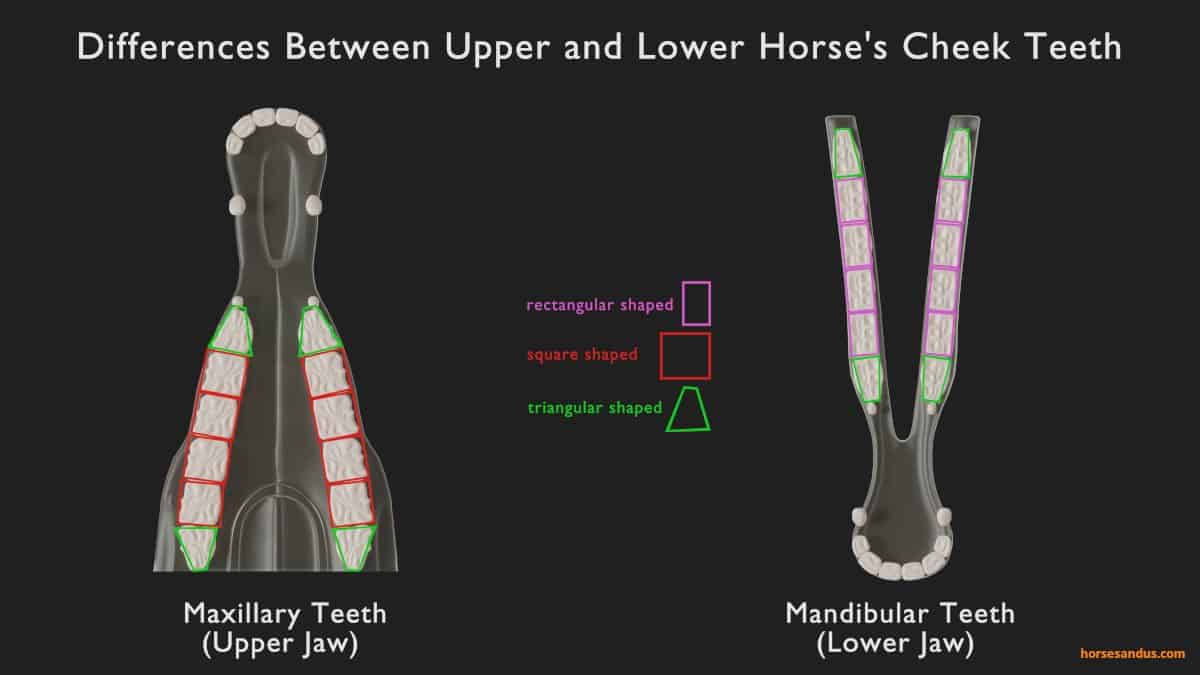
The Angulation Of Cheek Teeth Is Influenced By Diet
- For a horse that eats a normal forage diet where the coarse fibrous feed requires a wide range of lateral chewing movement, the angle remains within the normal range.
- For a horse that eats a diet based on concentrated feed, like processed grains, the chewing movement will be more vertical, will accentuate more the angle on the occlusal surface, and lead to a dental disorder called “shear mouth.”
How Does A Horse Chew?
Horses chew in a repetitive, cyclical motion with 3 phases: the mandible drops (opening stroke), then moves sideways and closes (closing stroke); finally, it slides sideways with cheek teeth in contact grinding the food (power stroke). The cycling motion can be clockwise or anti-clockwise as horses can be right-sided chewers, left-sided, or both.
The chewing process is crucial to prepare food for digestion. Throughout the whole digestive tract of the horse, there is no significant reduction in food size, which leaves chewing as the most important function to reduce food particle size.
How Anatomy Influences The Chewing Movement
To understand how a horse chews, let’s first take a quick look at the anatomy that impacts the chewing movement.
The anatomy of the horse’s mouth influences the chewing movement as follows:
1- In the resting position the incisors are aligned while the back cheek teeth are not touching each other (not in occlusion).

2- As the lower jaw moves to the side, the cheek teeth touch each other.

3- The incisors will need to separate to allow the check teeth to slide further laterally.
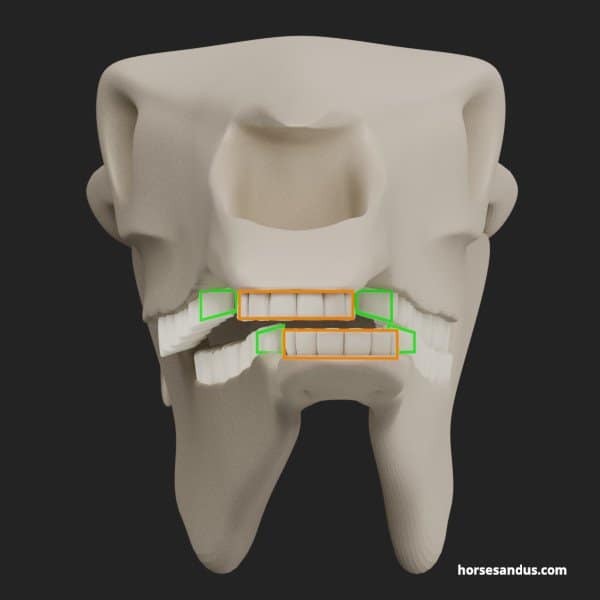
The Horse’s Chewing Cycle
Chewing is a repetitive, cyclical motion that has three phases:
- “O” – The opening stroke
- “C” – The closing stroke
- “P” – The Power stroke
The animation shows the complete chewing cycle in motion. Notice how the lower cheek teeth slide completely across the upper cheek teeth, wearing away the entire surface evenly.
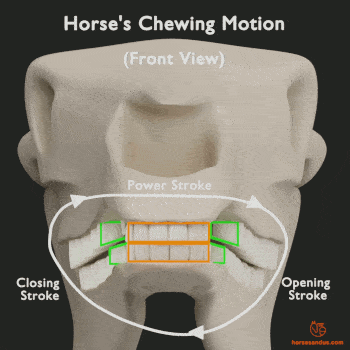
Some horses are right-sided chewers, others are left-sided, and still, others chew on both sides.
In a study made of the chewing movements in of 400 horses the following was observed:
- 163 (41%) were right-sided
- 131 (32%) were left-sided
- 45 (11%) chewed on both sides
- The remaining horses had incomplete observations
(source: Equine Dentistry – 3rd Edition, by Jack Easley, Padraic M. Dixon, James Schumacher)
How A Horse’s Diet Influences The Chewing Movement
Studies have shown that the chewing motion depends on the type of food being chewed.
Fiber Feed Requires more Movement Of The Jaw
When eating fiber feed such as grass or hay, there is a greater lateral movement of the lower jaw than when eating grains or pelleted food. This increased lateral movement will allow full contact of upper and lower cheek teeth during the chewing cycle.
When horses have free access to grass or hay and spend most of their day chewing this coarse feed, they will not develop significant wear abnormalities and so will have less need for dental treatments such as floating.
Grains and Pellets Requires Less Movement Of The Jaw
On the contrary, horses fed grains or pellets require less movement of the jaw (both side to side and front to back ) to chew this type of food. The limited motion influences teeth wear because there will only be partial contact with the upper and lower cheek teeth, and consequently, wear abnormalities such as “sharp enamel points” and “hooks” are frequent.
The animation shows how the reduced range of chewing motion does not completely wear the edges of the cheek teeth’ dental surface, causing sharp enamel points.
However, we must understand that performance horses require a high caloric diet, which is more easily met with concentrated foods such as grains and pellets. To manage this, more frequent dental interventions may be necessary to prevent and fix abnormal teeth wear caused by the reduced range of chewing movement associated with this type of diet.
Another problem that can appear when horses do not have free access to hay is that the horse may start chewing on wood. Horses have a need to chew coarse fiber, and if they do not have access to it, they may search for alternatives such as wood.
So giving your horse free access to hay will avoid not only abnormal teeth wear but also bad habits such as chewing on wood.
Sources
The following sources were used to research this article:
- Article1 from TheHorse
- Article2 from TheHorse
- Routine Dentistry in Juvenile Performance Horses
- Article from ResearchGate
The book: Equine Dentistry – by Jack Easley (Editor), Padraic M. Dixon (Editor), James Schumacher (Editor)
